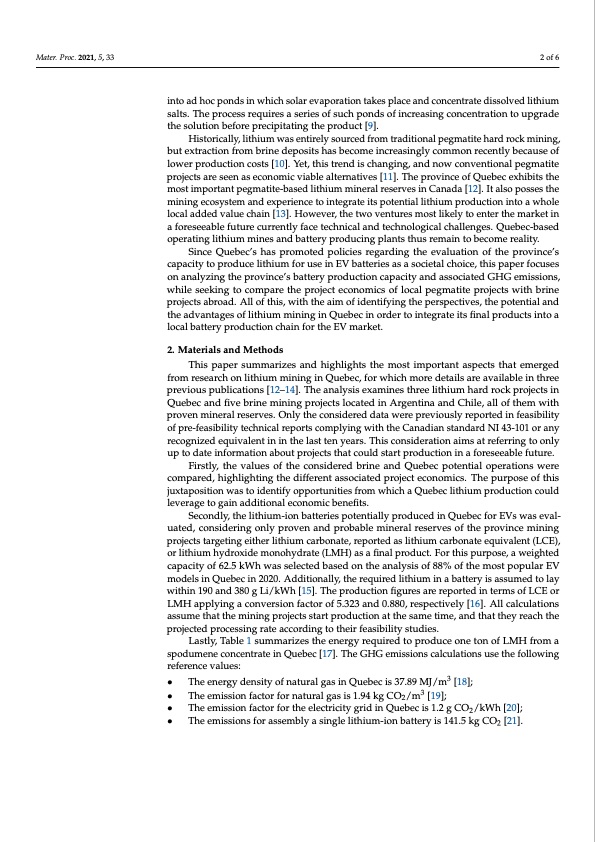
PDF Publication Title:
Text from PDF Page: 002
Mater. Proc. 2021, 5, 33 2 of 6 into ad hoc ponds in which solar evaporation takes place and concentrate dissolved lithium salts. The process requires a series of such ponds of increasing concentration to upgrade the solution before precipitating the product [9]. Historically, lithium was entirely sourced from traditional pegmatite hard rock mining, but extraction from brine deposits has become increasingly common recently because of lower production costs [10]. Yet, this trend is changing, and now conventional pegmatite projects are seen as economic viable alternatives [11]. The province of Quebec exhibits the most important pegmatite-based lithium mineral reserves in Canada [12]. It also posses the mining ecosystem and experience to integrate its potential lithium production into a whole local added value chain [13]. However, the two ventures most likely to enter the market in a foreseeable future currently face technical and technological challenges. Quebec-based operating lithium mines and battery producing plants thus remain to become reality. Since Quebec’s has promoted policies regarding the evaluation of the province’s capacity to produce lithium for use in EV batteries as a societal choice, this paper focuses on analyzing the province’s battery production capacity and associated GHG emissions, while seeking to compare the project economics of local pegmatite projects with brine projects abroad. All of this, with the aim of identifying the perspectives, the potential and the advantages of lithium mining in Quebec in order to integrate its final products into a local battery production chain for the EV market. 2. Materials and Methods This paper summarizes and highlights the most important aspects that emerged from research on lithium mining in Quebec, for which more details are available in three previous publications [12–14]. The analysis examines three lithium hard rock projects in Quebec and five brine mining projects located in Argentina and Chile, all of them with proven mineral reserves. Only the considered data were previously reported in feasibility of pre-feasibility technical reports complying with the Canadian standard NI 43-101 or any recognized equivalent in in the last ten years. This consideration aims at referring to only up to date information about projects that could start production in a foreseeable future. Firstly, the values of the considered brine and Quebec potential operations were compared, highlighting the different associated project economics. The purpose of this juxtaposition was to identify opportunities from which a Quebec lithium production could leverage to gain additional economic benefits. Secondly, the lithium-ion batteries potentially produced in Quebec for EVs was eval- uated, considering only proven and probable mineral reserves of the province mining projects targeting either lithium carbonate, reported as lithium carbonate equivalent (LCE), or lithium hydroxide monohydrate (LMH) as a final product. For this purpose, a weighted capacity of 62.5 kWh was selected based on the analysis of 88% of the most popular EV models in Quebec in 2020. Additionally, the required lithium in a battery is assumed to lay within 190 and 380 g Li/kWh [15]. The production figures are reported in terms of LCE or LMH applying a conversion factor of 5.323 and 0.880, respectively [16]. All calculations assume that the mining projects start production at the same time, and that they reach the projected processing rate according to their feasibility studies. Lastly, Table 1 summarizes the energy required to produce one ton of LMH from a spodumene concentrate in Quebec [17]. The GHG emissions calculations use the following reference values: • The energy density of natural gas in Quebec is 37.89 MJ/m3 [18]; • The emission factor for natural gas is 1.94 kg CO2/m3 [19]; • The emission factor for the electricity grid in Quebec is 1.2 g CO2/kWh [20]; • The emissions for assembly a single lithium-ion battery is 141.5 kg CO2 [21].PDF Image | Perspectives of Lithium Mining in Quebec

PDF Search Title:
Perspectives of Lithium Mining in QuebecOriginal File Name Searched:
materproc-05-00033.pdfDIY PDF Search: Google It | Yahoo | Bing
Product and Development Focus for Infinity Turbine
ORC Waste Heat Turbine and ORC System Build Plans: All turbine plans are $10,000 each. This allows you to build a system and then consider licensing for production after you have completed and tested a unit.Redox Flow Battery Technology: With the advent of the new USA tax credits for producing and selling batteries ($35/kW) we are focussing on a simple flow battery using shipping containers as the modular electrolyte storage units with tax credits up to $140,000 per system. Our main focus is on the salt battery. This battery can be used for both thermal and electrical storage applications. We call it the Cogeneration Battery or Cogen Battery. One project is converting salt (brine) based water conditioners to simultaneously produce power. In addition, there are many opportunities to extract Lithium from brine (salt lakes, groundwater, and producer water).Salt water or brine are huge sources for lithium. Most of the worlds lithium is acquired from a brine source. It's even in seawater in a low concentration. Brine is also a byproduct of huge powerplants, which can now use that as an electrolyte and a huge flow battery (which allows storage at the source).We welcome any business and equipment inquiries, as well as licensing our turbines for manufacturing.| CONTACT TEL: 608-238-6001 Email: greg@infinityturbine.com | RSS | AMP |